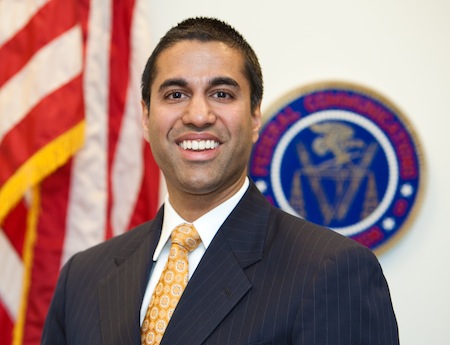Pai: FCC Needs to Show More Love to Broadcasters

Commissioner Ajit Pai was playing relationship counselor Monday as he advised a Pennsylvania Association of Broadcasters audience at their convention in Hershey, Pa., that the FCC needs to give their one-to-many architecture more love and to treat them well in the incentive auction.
But he didn't see the FCC ending its relationship with most media ownership regulations anytime soon.
"Unfortunately, the relationship between broadcasters and the FCC has become strained of late," he told the crowd. "Based on what I heard at the NAB Show last month, I wonder if it’s time to call Dr. Phil and see if he is available to mediate."
With no Dr. Phil in attendance, Pai stepped in with four areas where he suggested the relationship could be improved, mostly by changes on the FCC's side.
1. Pai said the FCC needs to better appreciate broadcasting's one-to-many architecture, something the National Association of Broadcasters has been saying for years.
"A one-to-one architecture is great for certain things, and a one-to-many architecture is better for others. For example, when the Philadelphia Eagles play the Kansas City Chiefs in next year’s Super Bowl, broadcast will be a much more efficient way to bring that clash of two football powerhouses to the American people than will broadband. And when I send gloating texts and tweets after Kansas City’s resounding victory, a broadband connection will be more useful," he said.
Then there is public safety, when the power goes out, broadcasters stay on. He said he was all for the Internet, but not for the FCC trying to "push" broadcasters into moving to online delivery, saying it was not his business to tell them how to run theirs. "[F]or all of the talk of over-the-top programming, it’s still over-the-air programming that draws the largest crowds."
Broadcasting & Cable Newsletter
The smarter way to stay on top of broadcasting and cable industry. Sign up below
2. The FCC needs to treat broadcasters fairly in the spectrum auction, he said. That means preserving a vibrant, free, over-the-air television system, not making broadcasters pay any relocation costs (i.e. thinking hard about a repacking plan that would cost more than the $1.75 billion the statute sets aside for those payments), and make it as easy as possible for broadcasters who do want to participate in the auction to do so, like making channel sharing rules easy to follow.
3. Reform AM radio.
4. "Modernize" media ownership rules. The FCC's media ownership item, voted on in March "kicked the can of reform down the road yet again," he said. But he added that, as a realist, he did not see the FCC modernizing the rules in the next couple of years.
"I sometimes hear people complain about certain regulations that they say are outdated and unfairly benefit broadcasters. But modernizing our rules can’t be a one-way street. We also need to reexamine all of the outdated rules that uniquely burden broadcasters, like our media ownership rules, and eliminate those as well. In short, our decisions should reflect a consistent regulatory philosophy instead of appearing to help or harm a particular segment of the industry."
Contributing editor John Eggerton has been an editor and/or writer on media regulation, legislation and policy for over four decades, including covering the FCC, FTC, Congress, the major media trade associations, and the federal courts. In addition to Multichannel News and Broadcasting + Cable, his work has appeared in Radio World, TV Technology, TV Fax, This Week in Consumer Electronics, Variety and the Encyclopedia Britannica.

